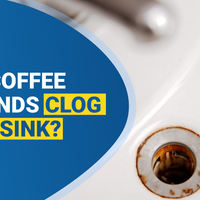Summary:
- Slow-draining sinks often stem from clogs caused by hair, soap scum, or grease buildup in drainpipes or P-traps.
- Ventilation issues, improper pipe slope, or mineral buildup can also restrict water flow and cause gurgling or backups.
- Damaged pipes or sewer line problems, like tree root intrusion, may lead to widespread drainage issues.
- DIY fixes like plunging, cleaning P-traps, or baking soda flushes can resolve minor clogs effectively.
- Persistent or multiple symptoms, such as recurring clogs or low pressure, require professional plumbing intervention.
A slow-draining sink is more than just an annoyance; it’s often a warning sign of underlying plumbing issues that can escalate into water damage, foul odors, or costly repairs if ignored.
Identifying the root cause is key to preventing bigger headaches.
This guide uncovers the top reasons your sink is draining slowly and provides practical steps to fix it.
Top Causes of a Slow-Draining Sink
Several issues can cause your sink to drain slowly, each with distinct symptoms and risks.
Clogged Drainpipe
Debris such as hair, soap scum, grease, or food particles often accumulate in drainpipes, restricting water flow. This shows up as water pooling around the drain, taking longer to empty. A bathroom sink used for daily grooming may collect hair and soap residue, slowing drainage over time.
Blocked P-Trap
The U-shaped P-trap under your sink holds water to block sewer gases but also traps debris like food scraps or grease. Over time, this sludge builds up, causing slow drainage and unpleasant odors.
Ventilation Issues
A blocked vent or overflow pipe creates negative pressure in the plumbing system, resulting in slow drainage or gurgling sounds after water flows. This might happen in a bathroom sink with a clogged overflow channel, disrupting smooth drainage. Without proper venting, the entire drainage system can malfunction, increasing the risk of backups and affecting multiple fixtures.
Improper Pipe Slope or Configuration
Pipes that aren’t angled correctly fail to use gravity effectively, causing water and debris to sit rather than flow. This leads to persistently slow drainage and recurring clogs.
Mineral Buildup from Hard Water
In areas with hard water, minerals like calcium and magnesium adhere to pipe walls, narrowing the passage and slowing drainage. This is common in regions with high mineral content, where sinks may gradually lose efficiency.
Damaged or Deteriorated Pipes
Aging or damaged pipes may crack, corrode, or collapse internally, obstructing water flow. Signs include slow drainage accompanied by leaks or puddles near the sink, such as under a bathroom vanity with rusted pipes.
Tree Roots or Main Sewer Problems
Tree roots infiltrating sewer lines or issues in the main sewer can block water flow, affecting multiple fixtures. If several sinks or toilets in your home drain slowly, this could be the culprit. These problems are serious, risking sewage backups and extensive damage.
Low Water Pressure
Insufficient water pressure reduces the force needed to flush debris through drainpipes, resulting in slow drainage and frequent minor clogs. This might occur in a home with an aging water supply system, where low pressure exacerbates buildup in kitchen sinks.
DIY Diagnosis & Fixes
Addressing a slow-draining sink early can prevent escalation. Start by removing and cleaning the sink’s stopper or pop-up, as hair and grime often tangle around it, especially in bathroom sinks used for grooming. Plunging the sink or using a Zip-It tool or hand snake can clear near-surface blockages.
Cleaning or replacing the P-trap involves unscrewing it, removing trapped gunk, and reattaching it to restore flow. Flushing the drain with hot water, not boiling, to avoid damaging PVC pipes, helps dissolve soap and grease buildup.
Moreover, a baking soda and vinegar treatment, using a 1:1 mix followed by warm water, naturally breaks up minor clogs.
When Do You Need Professional Help?
Some issues require expert intervention. If multiple sinks or drains are slow simultaneously, it suggests a deeper blockage in the main line or sewer. Persistent problems despite DIY attempts indicate a more complex issue. Blocked roof vents or hard-to-access pipe vents may need professional clearing as suspected pipe damage, root intrusion, or sewer line issues can be exacerbated.
Plumbers may use advanced solutions like camera inspections to diagnose blockages, hydro-jetting to clear pipes, or pipe rerouting to correct improper configurations, ensuring a safe and permanent fix.
Next Steps
Using a reliable drain catcher, like Drain Buddy Ultra Flo’s 2-in-1 stopper and hair catcher, traps hair and debris early, preventing clogs from forming. If multiple signs persist or severe symptoms like backups appear, call a plumber promptly for a thorough inspection to avoid costly repairs.
Final Word
Most slow-draining sinks start with common clogs from hair, soap, or grease, but issues like poor venting, improper pipe slope, or damaged pipes can also be culprits. By acting early with DIY fixes, regular maintenance, and tools like Drain Buddy Ultra Flo to catch debris, you can prevent minor issues from becoming major expenses.
Visit Drain Strain to explore innovative solutions and keep your sinks flowing freely.






